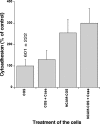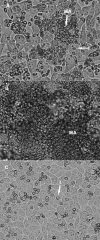Neural cell adhesion molecule, a new cytoadhesion receptor for Plasmodium falciparum-infected erythrocytes capable of aggregation
- PMID: 17485455
- PMCID: PMC1932966
- DOI: 10.1128/IAI.01852-06
Neural cell adhesion molecule, a new cytoadhesion receptor for Plasmodium falciparum-infected erythrocytes capable of aggregation
Abstract
The cytoadhesion of Plasmodium falciparum-infected erythrocytes (IEs) to the endothelial cells lining the microvasculature, clogging the microvessels of various organs, is a key event in the pathogenesis of certain severe forms of malaria, such as cerebral malaria and pulmonary edema. Studies aiming to identify possible correlations between the severity of clinical cases and the presence of particular cytoadhesion phenotypes have been largely unsuccessful. One of the possible reasons for this failure is that some of the key receptors and/or mechanisms involved have yet to be identified. By combining IE selection, cell transfection, and adhesion inhibition assays, we identified a new cytoadhesion receptor, neural cell adhesion molecule (NCAM). NCAM is a member of the immunoglobulin superfamily and has nonpolysialylated and polysialylated isoforms, the latter being rare in adults. The nonpolysialylated form is present on the surfaces of endothelial cells in the microvessels of various organs in which IE sequestration occurs. We found that multiphenotypic IEs interacted with nonpolysialylated NCAM and with another, as yet unidentified receptor. These IEs also displayed cytoadhesion in flow conditions, presenting the unique ability to form adherent macroaggregates composed of hundreds of IEs. These features may act as virulence factors, increasing the capacity of IEs to clog microvessels via receptor synergy and macroaggregate formation, thereby facilitating the pathogenesis of severe forms of malaria.
Figures




Similar articles
-
CD44, a signal receptor for the inhibition of the cytoadhesion of CD36-binding Plasmodium falciparum-infected erythrocytes by CSA-binding infected erythrocytes.Microbes Infect. 2007 Oct;9(12-13):1463-70. doi: 10.1016/j.micinf.2007.07.011. Epub 2007 Aug 7. Microbes Infect. 2007. PMID: 17913542
-
On the cytoadhesion of Plasmodium vivax-infected erythrocytes.J Infect Dis. 2010 Aug 15;202(4):638-47. doi: 10.1086/654815. J Infect Dis. 2010. PMID: 20617923
-
Platelets reorient Plasmodium falciparum-infected erythrocyte cytoadhesion to activated endothelial cells.J Infect Dis. 2004 Jan 15;189(2):180-9. doi: 10.1086/380761. Epub 2004 Jan 9. J Infect Dis. 2004. PMID: 14722881
-
A unified hypothesis for the genesis of cerebral malaria: sequestration, inflammation and hemostasis leading to microcirculatory dysfunction.Trends Parasitol. 2006 Nov;22(11):503-8. doi: 10.1016/j.pt.2006.09.002. Epub 2006 Sep 18. Trends Parasitol. 2006. PMID: 16979941 Review.
-
[Cerebral malaria, a key role for endothelial cells?].J Soc Biol. 2004;198(3):187-92. J Soc Biol. 2004. PMID: 15662934 Review. French.
Cited by
-
Characterisation of Plasmodium falciparum populations selected on the human endothelial receptors P-selectin, E-selectin, CD9 and CD151.Sci Rep. 2017 Jun 22;7(1):4069. doi: 10.1038/s41598-017-04241-3. Sci Rep. 2017. PMID: 28642573 Free PMC article.
-
Adhesion of Plasmodium falciparum-infected erythrocytes to human cells: molecular mechanisms and therapeutic implications.Expert Rev Mol Med. 2009 May 26;11:e16. doi: 10.1017/S1462399409001082. Expert Rev Mol Med. 2009. PMID: 19467172 Free PMC article. Review.
-
Peroxisome proliferator activating receptor (PPAR) in cerebral malaria (CM): a novel target for an additional therapy.Eur J Clin Microbiol Infect Dis. 2011 Apr;30(4):483-98. doi: 10.1007/s10096-010-1122-9. Epub 2010 Dec 9. Eur J Clin Microbiol Infect Dis. 2011. PMID: 21140187 Review.
-
Evidence of promiscuous endothelial binding by Plasmodium falciparum-infected erythrocytes.Cell Microbiol. 2014 May;16(5):701-8. doi: 10.1111/cmi.12270. Epub 2014 Feb 24. Cell Microbiol. 2014. PMID: 24444337 Free PMC article.
-
Knobs, Adhesion, and Severe Falciparum Malaria.Trop Med Infect Dis. 2023 Jul 4;8(7):353. doi: 10.3390/tropicalmed8070353. Trop Med Infect Dis. 2023. PMID: 37505649 Free PMC article. Review.
References
-
- Avril, M., B. Traore, F. T. Costa, C. Lepolard, and J. Gysin. 2004. Placenta cryosections for study of the adhesion of Plasmodium falciparum-infected erythrocytes to chondroitin sulfate A in flow conditions. Microbes Infect. 6:249-255. - PubMed
-
- Baruch, D. I., J. A. Gormely, C. Ma, R. J. Howard, and B. L. Pasloske. 1996. Plasmodium falciparum erythrocyte membrane protein 1 is a parasitized erythrocyte receptor for adherence to CD36, thrombospondin, and intercellular adhesion molecule 1. Proc. Natl. Acad. Sci. USA 93:3497-3502. - PMC - PubMed
-
- Blankenship, T. N., and B. F. King. 1996. Macaque intra-arterial trophoblast and extravillous trophoblast of the cell columns and cytotrophoblastic shell express neural cell adhesion molecule (NCAM). Anat. Rec. 245:525-531. - PubMed
-
- Burrows, T. D., A. King, and Y. W. Loke. 1994. Expression of adhesion molecules by endovascular trophoblast and decidual endothelial cells: implications for vascular invasion during implantation. Placenta 15:21-33. - PubMed
Publication types
MeSH terms
Substances
LinkOut - more resources
Full Text Sources
Research Materials
Miscellaneous

